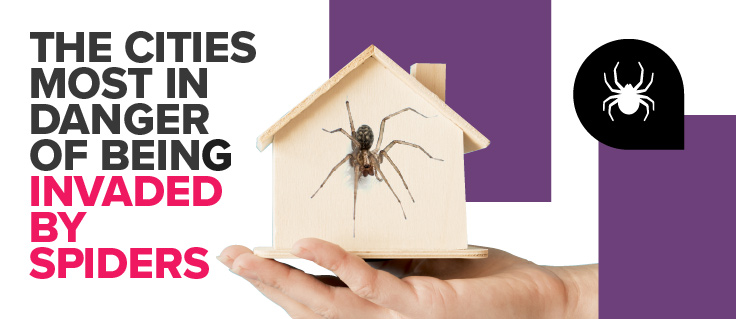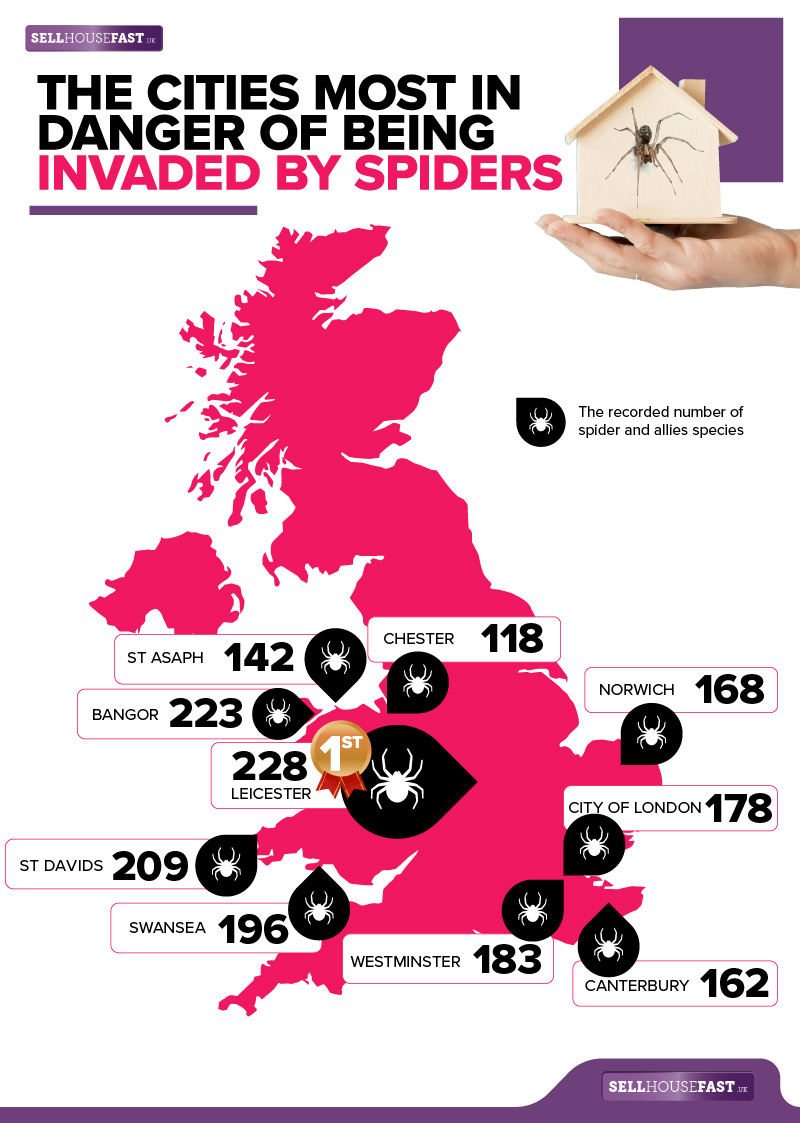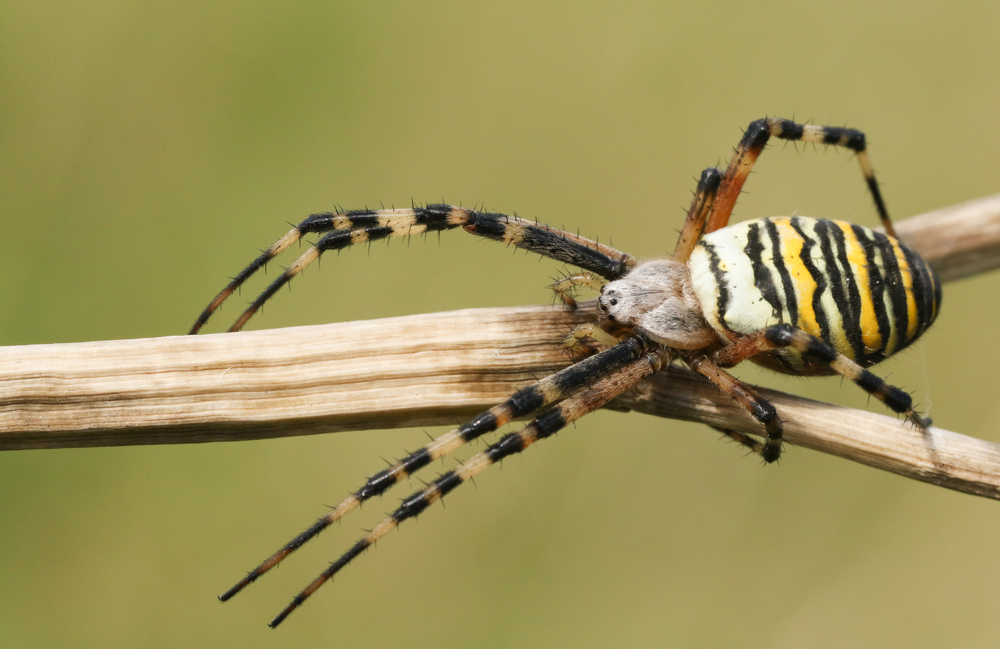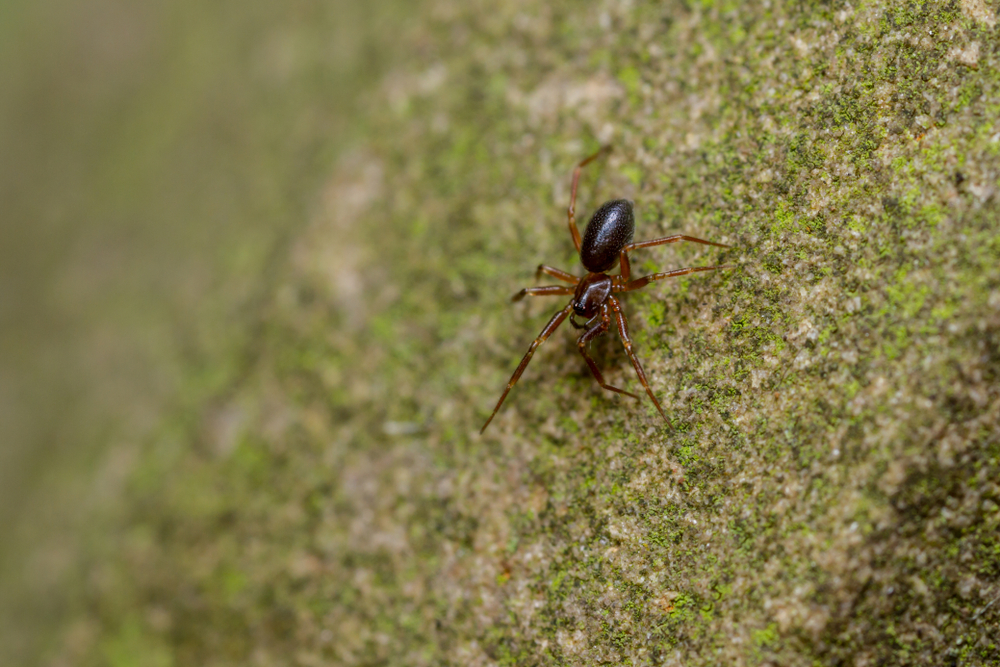
Top UK Cities Where Spiders Are Taking Over
Love them or hate them, spiders are all around us. Most of the time we rarely cross paths, but when we do, you can be certain the whole house (and street!) will know about it…
Spiders are most active during the autumn, so it’s likely you will see more during the months of September, October and November – especially in the home where spiders seek out warm and dry places to hide.
In the build-up to Halloween, the team at Sell House Fast sought to find out which spiders (and their allies) are most likely to invade our homes, and which areas of the UK are most likely to come into contact with the eight-legged creatures.
To do this, we utilised the ‘Explore Your Area’ tool on NBN Atlas to find out how many species of spiders (and allies) were recorded in 67 cities in the UK (within a 10km radius of the city centre).
The Cities Most Likely to be Invaded by Spiders:

1. Leicester
Homes in the city of Leicester are most in danger of being invaded
by spiders according to our research, with 228 different species of spiders and
allies recorded.
Pisaura Mirabilis, more commonly referred to as the Nursery Web Spider, is the most common spider species found in the
city, with 284 spiders recorded. The
Nursery Web Spider are easy to spot
as they have a long body with long legs and can be identified by the brown and
black stripes running the length of its body.
Araneus Diadematus, also known as the Garden Spider, is also commonly found in Leicester, with the species recorded 269 times by the All Taxa Records for Leicestershire and Rutland. Although extremely rare, the spider has been known to occasionally bite when aggravated – causing inflammation and itching for a few days.
2. Bangor
Coming in second place is Bangor, in Wales, with 223 different species of spiders and allies recorded.
The most common spider species found in the city is the Antistea Elegans, with 43 recorded.
The Argyroneta Aquatica, better known as the Water Spider, were also found to reside in Bangor, with three being recorded by the Welsh Invertebrate Database. They are the only known spider to live almost entirely under water, however when out of water, their colour ranges from mid to dark brown. This species is only known to bite when mishandled, with the bite often being compared to a bee sting!
3. St Davids
The second city most in danger of spider invasion is St Davids in Wales, with 209 different species reported.
The Antistea Elegans are the most common
spider species found in the city, with 54 recorded.
Another spider species found in the city is
Agelena Labyrinthica, also known as the Labyrinth Spider, and has
been recorded three times by the Welsh Invertebrate Database. Usually
found in long rough grass, the Labyrinth
Spider can be spotted by its central pale brown stripe. Although uncommon,
these critters can bite if aggravated.
4. Swansea
Third on the list is Swansea, with 196 different species of spiders
and allies found in the Welsh city.
Dolomedes Plantarius, known as the Great
Raft Spider, is the most common spider species found in the city, with 163 recorded.
Although only one species of the Labyrinth Spider has been recorded by the Welsh Invertebrate Database, be vigilant
as even though they are unlikely to bite and on rare occasions they can cause
allergic reactions.
5. Westminster
Fourth on the list is the city of Westminster,
with 183 recorded species.
The Chthonius
Ischnocheles species is the most common spider in Westminster, with almost
100 recorded (97).
According to the data resource Invertebrate Site Register – England, there have been two recorded species of the Garden Spider in the city. Garden Spiders grey-brown in colour with a white cross on their back. They are known for the spiral webs they create, which they will sit in to wait for prey, before wrapping them tightly and finishing them off with a venomous bite.

Wasp Spider | Photo credit: Sandra Standbridge / Shutterstock
6. City of London
In fifth place, we have the city of London, with
178 different species recorded.
Similarly to
Westminster, the Chthonius Ischnocheles
species was also the most common in the city of London, with 124 recorded.
According to the data resource IRecord Surveys, there is currently one recorded species of the Argiope Bruennichi – better known as the Wasp Spider due to the wasp-like yellow stripes found across their bodies. Although these creatures are capable of biting, but they are not a serious risk to humans.
7. Norwich
In sixth place is Norwich, with 168 different species of spiders
and allies recorded.
The most common spider species in Norwich is the Bathyphantes Gracilis, with 192
recorded.
According to the Norfolk and Suffolk Broads Invertebrate Data, two
species of the Labyrinth Spider have been recorded in the city.
Residents can easily pinpoint this spider by its
central pale brown stripe.
8. Canterbury
Canterbury comes in seventh place, with 162 recorded species – one
of which is the infamous Wasp Spider, recorded by IRecord Surveys.
Just like
Norwich, the Bathyphantes Gracilis is also the most common spider
in the city of Canterbury, with 27 of the eight-legged creatures recorded.
9. St Asaph
In eighth place is St Asaph in Wales, with 142
recorded species.
The Ixodes Vespertilionis are the most common species in St Asaph with 18 recorded.
Similarly to Bangor, St Asaph is also found to be home to the Argyroneta Aquatica (Water Spider). These critters have been known to bite when aggravated. Out of the water, these spiders range in colours from mid to dark brown and tend to have a velvet-like appearance.
10. Chester
In ninth place is Chester, with 118 species of spiders and allies
recorded.
The most common spider species found in Chester is the big bodied Antistea Elegans, with 22 recorded in the UK city.
Like Leicester and Westminster, the Garden Spider is also
among one of Chester’s spider species, as recorded by the Welsh Invertebrate
Database.

Garden Spider | Photo credit: Novama / Shutterstock
The Cities Least Likely to be Invaded by Spiders:
- Hereford – 3 recorded species
- Dundee – 4 recorded species
- Preston – 9 recorded species
- Birmingham – 12 recorded species
- Derry and Lancaster – 13 recorded species
- Leeds – 16 recorded species
- Aberdeen – 17 recorded species
- Chichester and Salford – 18 recorded species
- Manchester – 20 recorded species
- Lincoln, Liverpool and Coventry – 21 recorded species
The 10 Most Common Spiders found in UK Homes:
1. Giant House Spider
- Up to 12cm wide
- Typically dark orange, brown or beige in colour
- Commonly found in sheds and gardens
2. Zebra Jumping Spider
- Up to 8mm
- Distinctive white and black markings
- Found on external walls, but can also be found indoors by entering through open doors or windows
3. Cupboard Spider
- Up to 10mm
- Colour varies from dark purple, to brown, to black
- Often found in cupboards in houses and out-buildings
4. Daddy Long Legs
- Size varies, but they can reach up to 45mm
- Bodies are round or oval in shape and they possess thin long legs
- They live in many places, including forests, meadows, caves and wetlands
5. Money Spider
- No bigger than 5mm – the smallest spider in the UK
- Typically they have grey or black bodies, but some do have distinctive markings
- Often found on low growing vegetation and among piles of leaves

Money Spider | Photo credit: thatmacroguy / Shutterstock
6. Lace Web Spider
- Up to 12mm
- Brown with yellow markings on the abdomen
- Commonly found on outdoor walls and fences
7. Missing Sector Orb
- Up to 7mm
- Their abdomen is silver-grey with a brown pattern on the back
- Typically found on windowsills
8. False Widow Spider
- Around 20mm in size
- Dark brown is a bulbous abdomen
- Commonly found in porches, garages and lofts – they are sometimes found underneath kitchen appliances and cupboards too
9. Cardinal Spider
- Up to 14cm – the largest spider in the UK
- Typically reddish brown in colour, but young Cardinal spiders can be much lighter
- Typically found in buildings or on walls
10. Tube Web Spiders
- Up to 23mm
- It has six eyes arranged in three groups of two, with an iridescent green jaw
- Commonly found under stones or logs, and in holes on walls, trees and fences
Do you want to get out of a spider area?
Understandably you might want to move away fast from a spider zone – in which case you can get in touch at any time for a free valuation and no obligation cash offer from Sell House Fast as we buy houses under any circumstances. We provide cash for houses, enabling you to move on in a way that suits you.
You might also like: Britain’s Top 10 Most Haunted Houses
Special thanks and
acknowledgments to NBN Atlas and the Data Resources:
| HBRG Other Invertebrates Dataset |
| Opiliones (Harvestman) Dataset |
| Pseudoscorpion Recording Scheme Of The UK |
| CEDaR Online Recording |
| KiEco Freshwater Ecology: River Macroinvertebrates |
| Welsh Invertebrate Database (WID) |
|
Marine Data From Natural Resources Wales (NRW) Technical Support (Research & Monitoring) Contracts, Wales |
|
Marine Intertidal Phase 1 Species Dataset From The Countryside Council For Wales 1996-2005 |
| NRW Regional Data: North Wales |
| UK Biodiversity Action Plan Invertebrate Data For Wales |
| Ticks (Ixodidea) Distribution For The British Isles |
| Pseudoscorpion Recording Scheme – Records Verified Via IRecord |
| Invertebrate Site Register – England (1738-2005) |
|
Northern Ireland Environment Agency (NIEA) Collated Species Records |
| Patrick Roper’s Notebooks |
|
Bringing Reedbeds To Life Invertebrate Survey Of Three Key Reedbed Sites In England In 2009, 2010 |
| Dr Mary Gillham Archive Project |
| NRW Regional Data: South East Wales Non-Sensitive Species |
| IRecord Surveys |
| Natural England Marine Monitoring Surveys |
| DASSH Data Archive Centre – Statutory Surveys |
|
Marine Nature Conservation Review (MNCR) And Associated Benthic Marine Data Held And Managed By JNCC |
|
Invertebrate Common Standards Monitoring And ISIS Test Data |
| All Taxa Records For Leicestershire And Rutland |
|
Department Of Agriculture Environment And Rural Affairs (DAERA) Marine And Fisheries Division Marine Survey Data |
| Casual Records For Scottish Wildlife Trust Reserves |
| HBRG Other Invertebrates Dataset |
| National Trust For Scotland Species Records |
|
Commissioned Surveys And Staff Surveys And Reports For Scottish Wildlife Trust Reserves |
|
City Of Edinburgh Natural Heritage Service – Historical Records |
|
Caledonian Conservation Ltd Incidental Records 2014 Onwards |
| Urban Roots Malls Mire Invertebrate Records 2014 |
|
SNH Invertebrate Site Condition Monitoring 2013/14: Cadder Wilderness SSSI |
| Argyll Biological Records Dataset |
| BTCV Wildlife Counts Recording Workshops |
|
Gloucestershire Historic Wildlife Sightings Prior To 1st Jan 2000 |
| HBRG P.F. Entwistle Colln And Notebooks Dataset |
|
Marine Nature Conservation Review (MNCR) And Associated Benthic Marine Data Held And Managed By English Nature |
| MoJ BioBlitz August 2018 |
|
SNH Invertebrate Site Condition Monitoring 2015-16: Methven Woods SSSI |
| Marine Flora And Fauna Records From The North-East Atlantic |
| PondNet Data 2012-2014 |
|
SNH Invertebrate Site Condition Monitoring Of Invertebrate Assemblages At Ten SSSIs, 2011-12 |
| Shropshire Ecological Data Network Database |
| Species Found In The NOMS Estate 2005 – Present |
| Norfolk And Suffolk Broads Invertebrate Data 2007-2008 |
| Seasearch Marine Surveys In England |
| Species Found In The NOMS Estate 2005 – Present |
| Verified Marine Records From Indicia-Based Surveys |
| Marine Records From Pembrokeshire Marine Species Atlas |
* Please note: All data was collected between September 29th to 30th, 2020.


